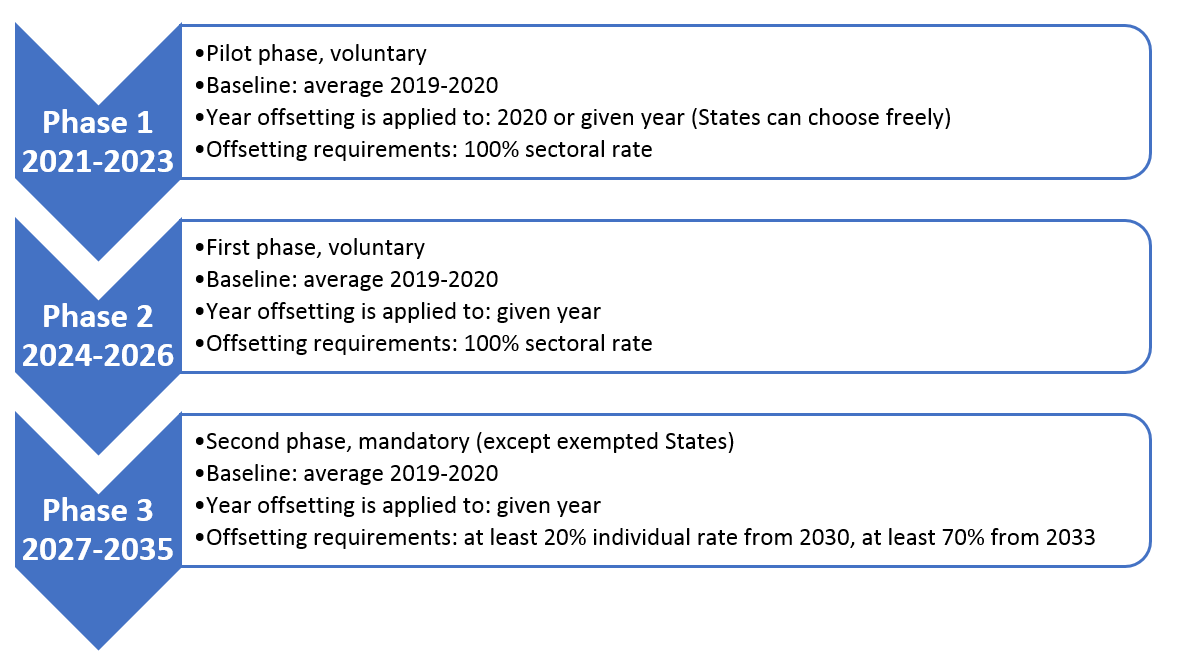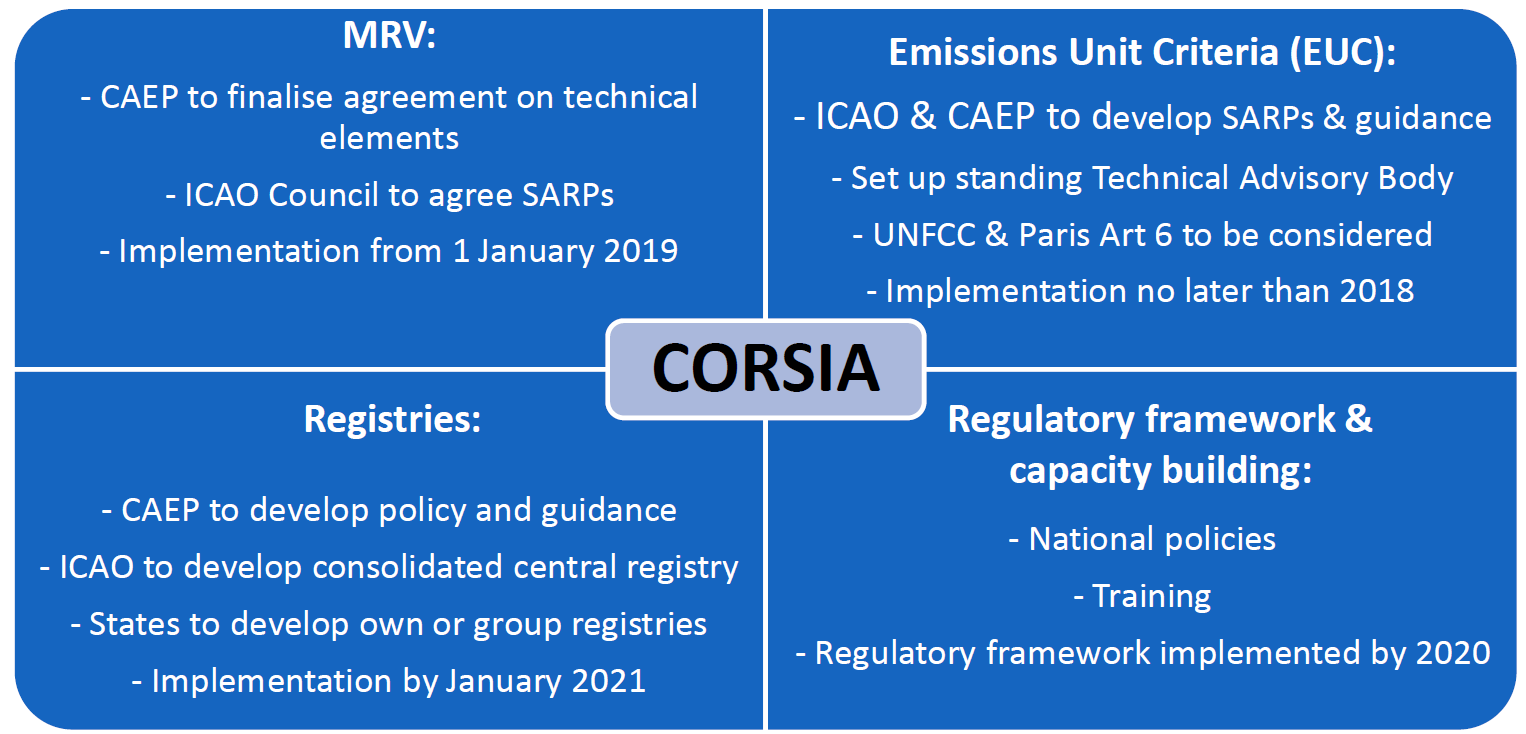ICAO's CORSIA
After 3 years of negotiations since the ICAO 38th Assembly in October 2013, the ICAO Member States agreed on October 6th 2016 to implement a Global Market-Based Measure (GMBM) to compensate post-2020 emissions growth from international aviation. The Plenary session of the UN aviation’s 39th assembly recommended the adoption of a final resolution introducing the Carbon Offset and Reduction Scheme for International Aviation (CORSIA).
Verifavia's Aviation MBM / MRV experts are closely following the updated information on CORSIA and also EU ETS in regards to the 39th Assembly outcome, and are available to train and support airlines on their way towards their first CORSIA verification..

Overview
Aviation accounts for about 2% of global emissions, and international aviation represents 1.3%. ICAO has been discussing the topic of CO2 emissions from international aviation for decades. However, in 2010, ICAO adopted two sectoral aspirational goals, 2% annual fuel efficiency improvement and carbon neutral growth from 2020.
In October 2013, the 38th Session of the ICAO Assembly adopted Resolution A38-18, which resolved that ICAO and its Member States, with relevant organizations, would work together and strive to achieve a collective medium-term global aspirational goal of keeping the global net CO2 emissions from international aviation after 2020 at the same level (so-called "carbon neutral growth from 2020" or CNG2020). The Assembly also defined a basket of measures designed to help achieve the ICAO's global aspirational goal. This basket includes improved aircraft technologies and procedures such as lighter airframes, higher engine performance and new certification standards, operational improvements (e.g. improved ground operations and air traffic management) and sustainable alternative fuels.
Unfortunately, these initiatives are largely surpassed by the predicted growth of the aviation sector. In order to achieve its goal, ICAO focused in the past three years on the last measure of the basket which is the global market-based measure, which is a preferred approach to local and regional initiatives.
Moreover, ICAO had to take into account the 2015 UNFCCC Paris agreement and complement its ambitions. The Paris agreement includes only domestic aviation and international aviation emissions are under ICAO’s responsibility.
How does CORSIA work?
ICAO has agreed that the GMBM will be a Carbon Offsetting and Reduction Scheme for International Aviation (CORSIA) rather than a cap and trade system like the EU ETS. This scheme will therefore require airlines to offset some of their emissions but not necessarily reduce their emissions.
According to the Assembly Resolution, the average level of CO2 emissions from international aviation covered by the scheme between 2019 and 2020 represents the basis for carbon neutral growth from 2020, against which emissions in future years are compared. In any year from 2021 when international aviation CO2 emissions covered by the scheme exceed the average baseline emissions of 2019 and 2020, this difference represents the sector's offsetting requirements for that year.
A phased-in implementation
ICAO has decided on a phase-in implementation to accommodate special circumstances and respective capabilities (SCRC) of contracting States. The scheme will be voluntary at the beginning, followed by participation of all States except the exempted States.
- Pilot phase (2021-2023) and First phase (2024-2026) apply to States that have volunteered to participate.
- Second phase (2027-2035) applies to all States except the exempted States unless they volunteer to participate.
Exempted states are all States that have an individual share of international aviation activities in RTKs in the year 2018 below 0.5 per cent of total RTKs or whose cumulative share in the list of States from the highest to the lowest amount of RTKs is less than 90 per cent of total RTKs. Exempted States are also Least Developed Countries (LDCs), Small Island Developing States (SIDS) and Landlocked Developing Countries (LLDCs).
States that decide to volunteer to participate may do so by joining from the January 1st of a given year and notifying ICAO of their decision by June 30 of the preceding year. The volunteering States have also the opt-out option. The same rules for notification apply.
As of September 2021, 107 States will participate in CORSIA from 1 January 2022.
> See full list of volunteers, mandatory participants and exempted States
Other exemptions
The CORSIA does not apply to low levels of international aviation activity to avoid administrative burden:
- aircraft operators emitting less than 10,000 metric tonnes of CO2 emissions from international aviation per year;
- aircraft with less than 5,700 kg of Maximum Take Off Mass (MTOM);
- or humanitarian, medical and firefighting operations.
A route-based approach
To ensure a level playing field between all airlines flying on the same route, the coverage of the scheme is defined on a route basis. A route will be covered by the scheme if both States connecting the route are participating in the scheme. A route will not be covered if at least one of the States connecting the route is not participating in the scheme. Emissions from international routes not covered by the scheme will not be redistributed. Coverage of routes can change over time as States decide to volunteer (or opt out) and once the scheme becomes mandatory.
Once the participation of States and routes covered by CORSIA in a given year is set, the offsetting requirements will be calculated. Offsetting requirements are the emissions which need to be offset, i.e. the emissions increased above the baseline. The baseline for CORSIA is determined as the average emissions from the years 2019 and 2020. The offsetting requirements are then distributed among aircraft operators as per the formula defined by the Resolution.
A 100% sectoral rate
The formula includes a dynamic approach for the distribution of the offsetting requirements. The "sectoral rate" represents the international aviation sector's global average growth factor of emissions in a given year, while the "individual rate" represents an individual operator's growth factor of emissions in a given year. The sectoral approach favours fast-growing airlines in emerging markets over mature, slower-growth airlines, but does not reward individual airline environmental performance. Airlines who take steps to decrease their own emissions in comparison to the baseline average will then be able to profit from individual rates. The sectoral and individual rates will move as follows:
- 2021-2029 – 100% sectoral rate and 0% individual rate
- 2030-2032 – at least 20% of individual rate
- 2033-2035 – at least 70% of individual rate

Impact on the Aviation EU ETS post-2016
In 2012, the European Commission agreed on the suspension of extra-EU flights from the EU ETS, the so-called “stop the clock”, in order to give ICAO time to reach a global agreement. This derogation automatically ceased from 1 January 2017, so the full scope of Aviation EU ETS is officially in force. The European Commission has proposed on the 3rd of February 2017 that a continuation of the ‘stop the clock’ intra-EEA scope of the EU Emissions Trading System (EU ETS) for aviation would be the most suitable option to address the period 2017-2020.
The Commission proposes to extend the current approach until there is sufficient clarity about the nature and content of the legal instruments adopted by ICAO for CORSIA to allow it to carry out further assessments and review the EU ETS for the post-2020 period.
Impact on the Aviation EU ETS post 2020
ICAO has noted and emphasized in the Resolution that CORSIA should be the single global carbon offsetting scheme instead of “patchwork of State and regional MBMs”. This is supposed to prevent double counting of emissions and be more cost-effective. In the view of this statement it seems unlikely that Aviation EU ETS would run in the form that it is in now post 2020.
There are several possibilities for post-2020 scenarios:
- the EU will close down Aviation EU ETS in its full scope and both intra- and extra-European flights will be covered by CORSIA;
- the EU might negotiate with ICAO to consider the EU as one State under the CORSIA and therefore keep using Aviation EU ETS as a scheme for its domestic flights, e.g. intra-European flights;
- the EU will continue Aviation EU ETS throughout the voluntary phases of CORSIA (until 2027) covering only extra-European flights with CORSIA non-exempted States that decided not to volunteer in the Pilot and the First Phase;
- the EU will continue EU ETS only for EU domestic flights, CORSIA will cover all international flights.
CORSIA’s cornerstones to be agreed upon and published by ICAO are the MRV (methodology for monitoring, reporting and verification of individual operators’ emissions), EUC (Emissions Unit Criteria) and the registries. However, ICAO has already stipulated in its Resolution that it will provide assistance to all states to put in place the necessary infrastructure and priority will be given to the States that volunteer.

Eligible carbon credits criteria
The airlines will be able to fulfil their offsetting requirements by purchasing offset credits from carbon markets. The emission units (one unit equals 1 tonne of CO2) will be therefore reduced outside of the aviation sector. Emissions Unit Criteria are yet to be worked out but it is clear that some carbon units generated from UNFCCC mechanisms and the Paris Agreement may be eligible for use in CORSIA provided they align with ICAO’s technical quality criteria and avoid double-counting. Offset units from UNFCCC Clean Development Mechanism and programme REDD+ will be most probably used.
The technical quality criteria of the emissions units used in CORSIA will be crucial. These criteria need to make sure that a tonne of CO2 emitted by an aircraft operator will be really equal to a tonne of CO2 saved somewhere else.









